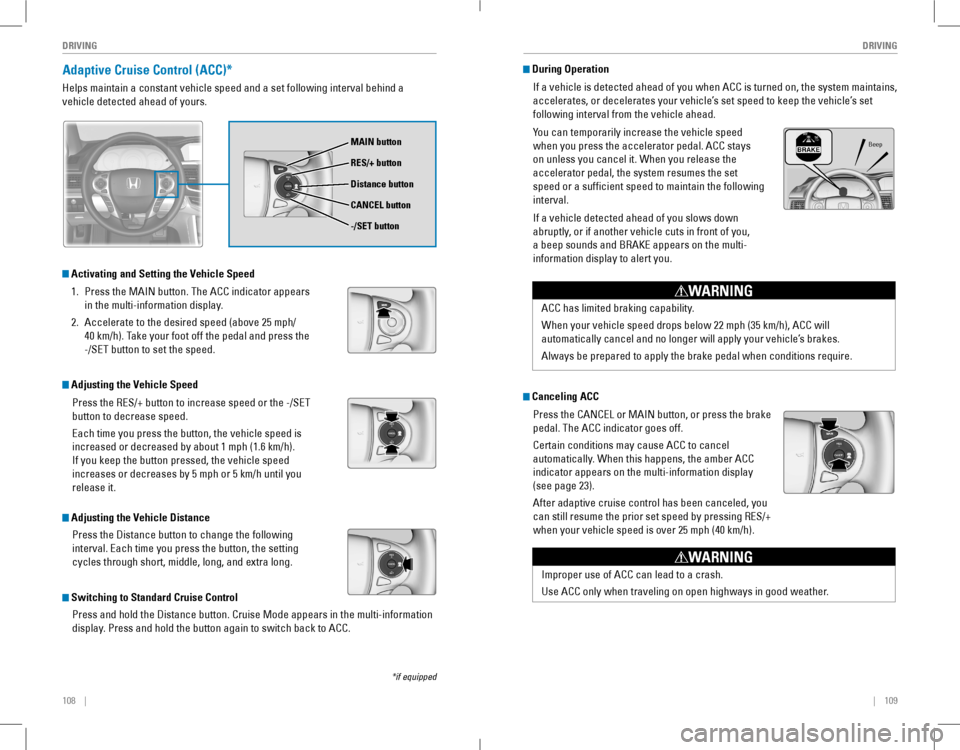brakes HONDA ACCORD COUPE 2016 9.G Quick Guide
[x] Cancel search | Manufacturer: HONDA, Model Year: 2016, Model line: ACCORD COUPE, Model: HONDA ACCORD COUPE 2016 9.GPages: 84, PDF Size: 19.4 MB
Page 56 of 84

104 || 105
DRIVINGDRIVING
*if‚Äāequipped
Shift up1 to 22 to 33 to 44 to 55 to 6
Normal acceleration17‚Äāmph‚Äā(27‚Äākm/h)29‚Äāmph‚Äā(46‚Äākm/h)37‚Äāmph‚Äā(60‚Äākm/h)43‚Äāmph‚Äā(69‚Äākm/h)49‚Äāmph‚Äā(79‚Äākm/h)
Recommended shift points (4-cylinder) LX-S‚Äā(U.S.)‚Äāand‚ÄāLX‚Äā(Canada)‚Äāmodels
Manual Transmission*
Fully press the clutch pedal to operate the shift lever
and change gears.
Do‚Äānot‚Äāshift‚Äāto‚ÄāReverse‚Äā(R)‚Äābefore‚Äāthe‚Äāvehicle‚Äācomes‚Äāto‚Äāa‚Äācomplete‚Äāstop.‚ÄāThis‚Äācan‚Äā
damage the transmission.
NOTICE
Shift up1 to 22 to 33 to 44 to 55 to 6
Normal acceleration17‚Äāmph‚Äā(28‚Äākm/h)27‚Äāmph‚Äā(44‚Äākm/h)36‚Äāmph‚Äā(57‚Äākm/h)41‚Äāmph‚Äā(66‚Äākm/h)44‚Äāmph‚Äā(71‚Äākm/h)
Recommended shift points (6-cylinder)
Before downshifting, make sure the engine will not go into the tachomete\
r’s red
zone.‚ÄāThis‚Äācan‚Äāseverely‚Äādamage‚Äāyour‚Äāengine.
NOTICE
Braking
Slow down or stop your vehicle, and keep it from moving when parked.
Foot Brake
Press‚Äāthe‚Äābrake‚Äāpedal‚Äāto‚Äāslow‚Äādown‚Äāor‚Äāstop‚Äāyour‚Äā
vehicle from moving.
Brake Assist System
During‚Äāhard‚Äāor‚Äāemergency‚Äābraking,‚Äāthe‚Äāsystem‚Äā
increases‚Äābraking‚Äāforce.‚ÄāThe‚Äābrake‚Äāpedal‚Äāmay‚Äāmove‚Äā
slightly or make a noise; this is normal. Continue to
hold‚Äāthe‚Äābrake‚Äāpedal‚Äāfirmly‚Äādown.‚Äā
Anti-Lock Brake System (ABS)
During‚Äāhard‚Äāor‚Äāemergency‚Äābraking,‚Äāthe‚Äāsystem‚Äā
rapidly‚Äāpumps‚Äāthe‚Äābrakes‚Äāto‚Äāprevent‚Äāwheel‚Äālockup‚Äā
and‚Äāhelp‚Äāyou‚Äāmaintain‚Äāsteering‚Äācontrol.‚ÄāThe‚Äābrake‚Äā
pedal may pulsate slightly during ABS operation;
this‚Äāis‚Äānormal.‚ÄāDo‚Äānot‚Äāpump‚Äāthe‚Äābrake‚Äāpedal,‚Äāand‚Äā
continue to hold it firmly down.
Parking Brake
Keep the vehicle from moving when it is parked.
To apply: Pull the lever up fully without pressing the
release‚Äābutton.‚Äā
To release:‚ÄāPress‚Äāand‚Äāhold‚Äāthe‚Äārelease‚Äābutton,‚Äāthen‚Äā
lower the lever down all the way.
Brake pedal
Brake pedal
The‚ÄāABS‚Äāmay‚Äānot‚Äāfunction‚Äācorrectly‚Äāif‚Äāyou‚Äāuse‚Äāan‚Äāincorrect‚Äātire‚Äātype‚Äāand‚Äāsize.‚Äā
NOTICE
Release‚Äāthe‚Äāparking‚Äābrake‚Äāfully‚Äābefore‚Äādriving.‚ÄāThe‚Äārear‚Äābrakes‚Äāand‚Äāaxle‚Äācan‚Äābe‚Äā
damaged‚Äāif‚Äāyou‚Äādrive‚Äāwith‚Äāthe‚Äāparking‚Äābrake‚Äāapplied.‚Äā
NOTICE
Shift up1 to 22 to 33 to 44 to 55 to 6
Normal acceleration15‚Äāmph‚Äā(24‚Äākm/h)25‚Äāmph‚Äā(40‚Äākm/h)40‚Äāmph‚Äā(64‚Äākm/h)47‚Äāmph‚Äā(76‚Äākm/h)52‚Äāmph‚Äā(84‚Äākm/h)
Recommended shift points (4-cylinder) Except‚ÄāLX-S‚Äā(U.S.)‚Äāand‚ÄāLX‚Äā(Canada)‚Äāmodels
Page 57 of 84

106 || 107
DRIVINGDRIVING
Eco Assist System
Can‚Äāhelp‚Äāimprove‚Äāfuel‚Äāeconomy‚Äāby‚Äāadjusting‚Äāthe‚Äāperformance‚Äāof‚Äāthe‚Äāengine,‚Äā
transmission, climate control system, and cruise control.
ECON Button
Press‚Äāthe‚ÄāECON‚Äābutton‚Äāto‚Äāturn‚Äāthe‚Äāsystem‚Äāon‚Äāor‚Äāoff.‚Äā
The eCoN Mode indicator and a message in the
multi-information‚Äādisplay*‚Äāappear‚Äāwhen‚Äāthe‚Äāsystem‚Äā
is turned on.
Ambient Meter
Color-coded‚Äābars‚Äāchange‚Äābased‚Äāon‚Äāyour‚Äādriving‚Äā
style‚Äāand‚Äābrake‚Äāor‚Äāaccelerator‚Äāpedal‚Äāoperation.
Green: Fuel-efficient driving
Light green:‚ÄāModerate‚Äāacceleration/deceleration
White:‚ÄāAggressive‚Äāacceleration/deceleration
Ambient meter
Vehicle Stability Assist (VSA¬ģ), aka Electronic Stability Control
(ESC) System
Helps‚Äāto‚Äāstabilize‚Äāthe‚Äāvehicle‚Äāduring‚Äācornering‚Äāif‚Äāthe‚Äāvehicle‚Äāturns‚Äāmore‚Äāor‚Äāless‚Äā
than‚Äāwhat‚Äāwas‚Äāintended.‚ÄāIt‚Äāassists‚Äāin‚Äāmaintaining‚Äātraction‚Äāon‚Äāslippery‚Äāsurfaces‚Äāby‚Äā
regulating‚Äāengine‚Äāoutput‚Äāand‚Äāselectively‚Äāapplying‚Äāthe‚Äābrakes.
Turning VSA On or Off
vSA is turned on every time you start the engine,
even‚Äāif‚Äāyou‚Äāpreviously‚Äāturned‚Äāit‚Äāoff.‚ÄāIf‚Äāyou‚Äāturn‚ÄāVSA‚Äā
off,‚Äāyour‚Äāvehicle‚Äāhas‚Äānormal‚Äābraking‚Äāand‚Äācornering‚Äā
ability,‚Äābut‚ÄāVSA‚Äātraction‚Äāand‚Äāstability‚Äāenhancement‚Äā
become‚Äāless‚Äāeffective.
Press‚Äāand‚Äāhold‚Äāthe‚ÄāVSA‚ÄāOFF‚Äābutton‚Äāuntil‚Äāyou‚Äāhear‚Äāa‚Äā
beep‚Äāto‚Äāturn‚ÄāVSA‚Äāon‚Äāor‚Äāoff.‚ÄāThe‚ÄāVSA‚ÄāOFF‚Äāindicator‚Äā
appears when the system is off.
Traction‚Äācontrol‚Äābecomes‚Äāless‚Äāeffective,‚Äāwhich‚Äāmay‚Äāmake‚Äāit‚Äāeasier‚Äāwhen‚Äātrying‚Äāto‚Äā
free your vehicle if it is stuck in mud or snow.
VSA OFF indicator
*if‚Äāequipped
Cruise Control*
Maintain a constant vehicle speed without having to keep your foot on th\
e
accelerator pedal. Use cruise control on freeways or open roads where yo\
u can
travel at a constant speed with little acceleration or deceleration.
Activating and Setting the Vehicle Speed
1. Press‚Äāthe‚ÄāCRUISE‚Äābutton.‚ÄāThe‚ÄāCRUISE‚ÄāMAIN‚Äāindicator‚Äā
appears.
2. Accelerate‚Äāto‚Äāthe‚Äādesired‚Äāspeed‚Äā(above‚Äā25‚Äāmph/
40‚Äākm/h).‚ÄāTake‚Äāyour‚Äāfoot‚Äāoff‚Äāthe‚Äāpedal‚Äāand‚Äāpress‚Äāthe‚Äā-/
SET‚Äābutton‚Äāto‚Äāset‚Äāthe‚Äāspeed.‚ÄāThe‚ÄāCRUISE‚ÄāCONTROL‚Äā
indicator appears.
Adjusting the Vehicle Speed
Press‚Äāthe‚ÄāRES/+‚Äābutton‚Äāto‚Äāincrease‚Äāspeed,‚Äāor‚Äāthe‚Äā-/SET‚Äā
button‚Äāto‚Äādecrease‚Äāspeed.
Each‚Äātime‚Äāyou‚Äāpress‚Äāthe‚Äābutton,‚Äāthe‚Äāvehicle‚Äāspeed‚Äāis‚Äā
increased‚Äāor‚Äādecreased‚Äāby‚Äāabout‚Äā1‚Äāmph‚Äā(1.6‚Äākm/h).‚ÄāIf‚Äāyou‚Äā
keep‚Äāthe‚Äābutton‚Äāpressed,‚Äāthe‚Äāvehicle‚Äāspeed‚Äāincreases‚Äāor‚Äā
decreases until you release it.
Canceling Cruise Control
Press‚Äāthe‚ÄāCANCEL‚Äābutton‚Äāor‚Äāthe‚Äābrake‚Äāpedal.‚ÄāThe‚ÄāCRUISE‚Äā
CoNTroL indicator goes off.
After‚Äācruise‚Äācontrol‚Äāhas‚Äābeen‚Äācanceled,‚Äāyou‚Äācan‚Äāstill‚Äā
resume‚Äāthe‚Äāprior‚Äāset‚Äāspeed‚Äāby‚Äāpressing‚Äāthe‚ÄāRES/+‚Äābutton‚Äā
while‚Äādriving‚Äāat‚Äāa‚Äāspeed‚Äāof‚Äāat‚Äāleast‚Äā25‚Äāmph‚Äā(40‚Äākm/h).
Press‚Äāthe‚ÄāCRUISE‚Äābutton‚Äāto‚Äāturn‚Äāthe‚Äāsystem‚Äāoff.
*if‚Äāequipped
Improper‚Äāuse‚Äāof‚Äācruise‚Äācontrol‚Äācan‚Äālead‚Äāto‚Äāa‚Äācrash.
Use cruise control only when traveling on open highways in good weather.
WARNING
CRUISE‚Äābutton
RES/+‚Äābutton
-/SET‚Äābutton
CANCEL‚Äābutton
Page 58 of 84

108 || 109
DRIVINGDRIVING
*if‚Äāequipped
Adaptive Cruise Control (ACC)*
Helps‚Äāmaintain‚Äāa‚Äāconstant‚Äāvehicle‚Äāspeed‚Äāand‚Äāa‚Äāset‚Äāfollowing‚Äāinterval‚Äābehind‚Äāa‚Äā
vehicle detected ahead of yours.
Activating and Setting the Vehicle Speed
1. Press‚Äāthe‚ÄāMAIN‚Äābutton.‚ÄāThe‚ÄāACC‚Äāindicator‚Äāappears‚Äā
in the multi-information display.
2. Accelerate‚Äāto‚Äāthe‚Äādesired‚Äāspeed‚Äā(above‚Äā25‚Äāmph/
40‚Äākm/h).‚ÄāTake‚Äāyour‚Äāfoot‚Äāoff‚Äāthe‚Äāpedal‚Äāand‚Äāpress‚Äāthe‚Äā
-/SET‚Äābutton‚Äāto‚Äāset‚Äāthe‚Äāspeed.‚Äā
Adjusting the Vehicle Speed
Press‚Äāthe‚ÄāRES/+‚Äābutton‚Äāto‚Äāincrease‚Äāspeed‚Äāor‚Äāthe‚Äā-/SET‚Äā
button‚Äāto‚Äādecrease‚Äāspeed.
Each‚Äātime‚Äāyou‚Äāpress‚Äāthe‚Äābutton,‚Äāthe‚Äāvehicle‚Äāspeed‚Äāis‚Äā
increased‚Äāor‚Äādecreased‚Äāby‚Äāabout‚Äā1‚Äāmph‚Äā(1.6‚Äākm/h).‚Äā
If‚Äāyou‚Äākeep‚Äāthe‚Äābutton‚Äāpressed,‚Äāthe‚Äāvehicle‚Äāspeed‚Äā
increases‚Äāor‚Äādecreases‚Äāby‚Äā5‚Äāmph‚Äāor‚Äā5‚Äākm/h‚Äāuntil‚Äāyou‚Äā
release it.
Adjusting the Vehicle Distance
Press‚Äāthe‚ÄāDistance‚Äābutton‚Äāto‚Äāchange‚Äāthe‚Äāfollowing‚Äā
interval.‚ÄāEach‚Äātime‚Äāyou‚Äāpress‚Äāthe‚Äābutton,‚Äāthe‚Äāsetting‚Äā
cycles through short, middle, long, and extra long.
Switching to Standard Cruise Control
Press‚Äāand‚Äāhold‚Äāthe‚ÄāDistance‚Äābutton.‚ÄāCruise‚ÄāMode‚Äāappears‚Äāin‚Äāthe‚Äāmulti-information‚Äā
display.‚ÄāPress‚Äāand‚Äāhold‚Äāthe‚Äābutton‚Äāagain‚Äāto‚Äāswitch‚Äāback‚Äāto‚ÄāACC.
MAIN button
RES/+ button
CANCEL button
-/SET button
Distance button
During Operation
If‚Äāa‚Äāvehicle‚Äāis‚Äādetected‚Äāahead‚Äāof‚Äāyou‚Äāwhen‚ÄāACC‚Äāis‚Äāturned‚Äāon,‚Äāthe‚Äāsystem‚Äāmaintains,‚Äā
accelerates, or decelerates your vehicle’s set speed to keep the vehicle’s set
following interval from the vehicle ahead.
You can temporarily increase the vehicle speed
when you press the accelerator pedal. ACC stays
on‚Äāunless‚Äāyou‚Äācancel‚Äāit.‚ÄāWhen‚Äāyou‚Äārelease‚Äāthe‚Äā
accelerator pedal, the system resumes the set
speed or a sufficient speed to maintain the following
interval.
If‚Äāa‚Äāvehicle‚Äādetected‚Äāahead‚Äāof‚Äāyou‚Äāslows‚Äādown‚Äā
abruptly,‚Äāor‚Äāif‚Äāanother‚Äāvehicle‚Äācuts‚Äāin‚Äāfront‚Äāof‚Äāyou,‚Äā
a‚Äābeep‚Äāsounds‚Äāand‚ÄāBRAKE‚Äāappears‚Äāon‚Äāthe‚Äāmulti-
information display to alert you.
ACC‚Äāhas‚Äālimited‚Äābraking‚Äācapability.‚Äā
When‚Äāyour‚Äāvehicle‚Äāspeed‚Äādrops‚Äābelow‚Äā22‚Äāmph‚Äā(35‚Äākm/h),‚ÄāACC‚Äāwill‚Äā
automatically‚Äācancel‚Äāand‚Äāno‚Äālonger‚Äāwill‚Äāapply‚Äāyour‚Äāvehicle‚Äôs‚Äābrakes.‚Äā
Always‚Äābe‚Äāprepared‚Äāto‚Äāapply‚Äāthe‚Äābrake‚Äāpedal‚Äāwhen‚Äāconditions‚Äārequire.‚Äā
WARNING
Canceling ACC
Press‚Äāthe‚ÄāCANCEL‚Äāor‚ÄāMAIN‚Äābutton,‚Äāor‚Äāpress‚Äāthe‚Äābrake‚Äā
pedal. The ACC indicator goes off.
Certain conditions may cause ACC to cancel
automatically.‚ÄāWhen‚Äāthis‚Äāhappens,‚Äāthe‚Äāamber‚ÄāACC‚Äā
indicator appears on the multi-information display
(see page 23).
After‚Äāadaptive‚Äācruise‚Äācontrol‚Äāhas‚Äābeen‚Äācanceled,‚Äāyou‚Äā
can‚Äāstill‚Äāresume‚Äāthe‚Äāprior‚Äāset‚Äāspeed‚Äāby‚Äāpressing‚ÄāRES/+‚Äā
when‚Äāyour‚Äāvehicle‚Äāspeed‚Äāis‚Äāover‚Äā25‚Äāmph‚Äā(40‚Äākm/h).‚Äā
Improper‚Äāuse‚Äāof‚ÄāACC‚Äācan‚Äālead‚Äāto‚Äāa‚Äācrash.‚Äā
Use ACC only when traveling on open highways in good weather.
WARNING
Beep